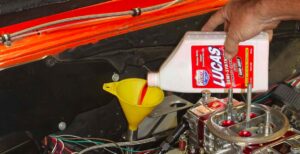Everyone knows the importance of maintaining their vehicles. A well-maintained vehicle means a healthy car that will improve not only its efficiency but also its life. Engine oil shouldn’t be the last item on your mind, even if you undoubtedly have more important things to worry about, including the car’s brakes and transmission. It is one of the numerous inconveniences a car owner deals with, but maintaining your vehicle in good shape is essential.
The frequency of oil changes can vary depending on how you use the automobile, but the most important thing is that you change the oil and don’t drive without it. Oil change experts have established a typical threshold beyond which the car requires your attention.
Table of Contents
Time Between Oil Changes
Manufacturers and experts advised a 3-month interval or when the automobile hits 3000 kilometers for older model cars. The technology in modern vehicles has advanced so much that you won’t need to change the oil until you’ve driven 5000–7500 miles.
Additionally, the car itself alerts you when the time comes. After the lights turn on, you can continue for a few hundred miles, but the sooner you change, the better.
Few people want to push their cars as far as possible because doing so harms the engine. It’s best not to make your luck by trying to save a few bucks to spend thousands more.
However, these are broad recommendations that may change depending on the following elements:
- Age of the vehicle: older models need more oil changes than newer ones.
- Make and model: Car models may need oil changes at different intervals. For that, refer to the manufacturer’s manual. Did you know that extended travels are easier on the car than short ones? On the other hand, driving in congested areas and making short journeys. Therefore, your mechanic would advise routine oil changes if you fall into the latter category.
- Oil type: Synthetic oils provide you significantly more miles between oil changes.
Even with the aforementioned in mind, below are a few situations where your car may require regular oil changes.
Driving in subfreezing temperatures, many little trips of 5 miles or less, being stuck in traffic, moving large pieces of equipment, and traveling on roads with gravel, dust, or sand are typically bad for the car.
Oil Changes for Older Cars
Depending on how you drive your older car, both regularly and when you put it through a lot more use, you may need to change the oil. Using your automobile for short journeys that involve prolonged periods of stop-and-go driving might be said to be “tasked.” Other situations include using it for heavy hauling or driving in adverse weather.
Naturally, you’d need to change the oil more frequently if you task your car a lot. We advise against keeping an older heavy-duty vehicle for longer than 3,000 kilometers.
Oil Change For Newer Cars
Newer cars have oil-life monitoring devices that detect when you need to change your oil, as we have discussed. When the oil starts to deteriorate, some systems use time and mileage while others use driving circumstances.
When it’s time to replace the oil, you receive a notification on the dashboard regardless of the oil monitoring system. Therefore, with modern cars, it is much clearer how long your vehicle should go without an oil change. Delaying an oil change after receiving a warning for one puts your engine at risk and raises the likelihood of expensive damages.
Nevertheless, oil technology also has an impact on the time frames. How long can I go without having synthetic oil changed? Depending on the age of the vehicle and the driver’s behavior, engines running on synthetic oil have been known to travel up to 15,000 miles between oil changes.
Why Do Oil Changes Matter?
Improves mileage
A properly oiled car operates so efficiently that you can reduce fuel use. For the engine to function as it should, you must keep a specific motor oil level in the automobile and replenish it at particular intervals. According to the U.S. Department of Energy, changing your oil regularly will increase your mileage by 2%. Although it might not seem like a large sum, it can result in significant savings for a typical car.
Lubricates the engine
Picture the engine’s components wearing out over time while operating the car at high speed, producing heat. If lubrication is neglected, these vital components found under a car’s hood won’t work properly. Without lubrication, the condition will significantly reduce the vehicle’s efficiency. Therefore, be sure to maintain the necessary level of fill. You can consult the manual that comes with the car to find out what grade or amount of oil you can use for this.
Suppose you are unaware of the type of oil to use or how to replace it. In that case, you can also get in touch with a reputable car repair service provider.
Keeps the Engine Temperature Cool
The amount of heat produced would be enormous if the parts weren’t cooled, given the number of moving parts and their rate of motion.
By reducing friction between the moving parts, engine oil provides cooling. Therefore, you must keep the car’s oil level properly.
Gets Rid of Sludge
The engine oil collects the dirt, dust, and debris that accumulate on the engine after several months or years of operation. These foreign substances may corrode the engine and cause damage. They degrade over time and produce a sludge that impairs performance.
The engine is maintained in good working order with routine oil changes. The mechanic replaces the old, dirty oil with a fresh one after flushing the old, sludged oil.
Reduces Wear and Tear
The valves, piston, and crankshaft assembly are among the engine’s moving parts, and they need lubricant to be protected.
Lack of one or oil that has outlived its usefulness can cause the engine to rust, causing significant wear and tear.
Extends the life of the engine
The car will take care of itself as long as you are careful to maintain the engine and its components.
Regular maintenance, such as oil changes, prevents the buildup of hazardous substances and keeps the car operating smoothly without unnecessary stress.
It enables the engine to operate at its peak efficiency without becoming overly stressed. Both the engine’s and the car’s life are lengthened by it.
Signs That Your Cars Needs an Oil Change
The Engine’s Noise
Oil supplies the lubrication the car’s engine needs to run smoothly. The engine’s parts rub against one other, making noises when the levels are low, or the viscosity varies.
Be aware that an engine may be in danger owing to a lack of oil if you hear a knocking or rumbling sound. Take your car in immediately away because this is an emergency.
Smoke From The Exhaust
The car emits a clear mist when you drive it. It is necessary to replenish the oil if it starts to smoke. It might also be a sign of an oil leak or trouble with the engine.
A Change In The Oil’s Color
A clear, amber-colored oil should have these characteristics. You should be able to see the dipstick sink into the oil when you insert it. Darker brown-colored dirty oil signals that changing the hue is time to change.
Check the viscosity and oil levels using the dipstick once a month if you don’t already have a monitoring system in place.
The Oil Change Warning Light
When it’s time to replace the oil, the indicator light on your car will turn on if it has an oil monitoring system. Check the conditions and the levels with your dipstick.
When the oil is low, and the engine is having problems, the check engine light will come on. Get your car to an auto repair shop as soon as both light up.
The Car Has An Oily Smell
Inside the automobile, you should be able to smell oil or gas odors. If you detect one, the engine is having issues. The smell of oil is due to the leak of engine oil.
On the other hand, if you smell gas, your automobile may be overheating and the reason why. Schedule maintenance as soon as you can in any scenario.
How Many Months Can You Go Without Getting An Oil change?
That depends on the age, driving habits, and environmental factors of the vehicle, as well as the manufacturer. It used to happen after three months in the past. All of that has changed due to advancements in oil technology and car engines since cars today last a lot longer than oil changes. Even automakers advise a six-month gap, though others recommend longer intervals.
Can A Car Last a Year Without An Oil Change?
The quick response is no. You shouldn’t let a year pass before changing the oil on your automobile, even if it hasn’t reached the suggested mileage for an oil change. Fat can spoil if it stays in the engine for too long. It eventually loses viscosity and cannot properly lubricate the engine’s parts. Because of this, regardless of mileage, you should change it at least once every year.
How Long Does Changing The Oil Take?
Although a tedious operation, changing the oil is a must. However, the wait would be more time-consuming than the work itself.
Honestly, disregarding waiting time, changing the oil in the car should only take your mechanic about 15 minutes. To shorten the wait, it is preferable to make an appointment with an auto repair business.
How Long Can I Go With Synthetic Oil Before Changing it?
You can drive with synthetic oils for up to 10,000 miles, and in some high-end vehicles, up to 15,000 miles. Since synthetics do not break down like conventional oil, they are superior.
Additionally, it can withstand sudden fluctuations in temperature, especially below freezing. Unlike regular motor oil, synthetic oils flow readily when the car is started.
Price To Change the Oil
The oil manufacturer you select will have an impact on the cost. There are cheaper oils and more expensive oil varieties. Furthermore, not all oils can be used in all kinds of vehicles. While changing synthetic oil can cost between $65 and 125, replacing conventional oil can cost between $30 and 75.
What Happens If I Don’t Replace the Oil?
It’s natural to put off getting your oil changed as long as you can if your engine will let you. Is that, however, secure for your machine?
No matter how long you extend the time, the oil cannot adequately circulate and lubricate the engine. The oil collects dust, grime, metal shavings, and other debris as it circulates through the machine. After that, the oil filter cleans the oil by capturing the dirt.
Skip an oil change, and the oil becomes increasingly murky due to the filter’s inability to function effectively. The oil feels sludgy because of its foreign materials, which keeps it from doing its job. Over time, the oil starts to thin out and loses some of its constituents.
The oil eventually becomes abrasive, which harms the engine components. Attempts to stretch your budget end up costing you hundreds of dollars.
Conclusion
For the engine to operate at its best, experts advise changing the oil every 5000–7500 miles.
If you drive in the following circumstances, it will still be 3000 miles:
- in a busy environment
- frequently cover small distances
- carry heavy equipment
- dusty or gravelly roads
The kind and age of the car can play a role. Oil changes are more frequent on older models of cars than on newer ones.
In the sense that it necessitates an oil change every 10,000 or 15,000 miles, synthetic oil surpasses all of these.
For the engine to function as it should, engine oil is required. The advantages of using clean engine oil are as follows.
- Lubrication/Cooling
- fuel efficiency
- eliminates foreign objects
Modern vehicles come with an oil monitoring system that indicates when the oil needs to be changed. In addition, you can use the dipstick to check the oil’s viscosity and color, which signals that a change is required.
We advise that you have an oil change every a few thousand miles or as soon as your dashboard indicates that you need one. Even better, we recommend you follow the manufacturer’s instructions in your car’s owner’s manual.




